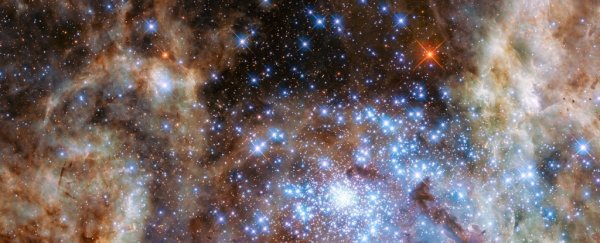If life is to spark in the Universe like it does on Earth, a few things seem to be required, such as an atmosphere, ozone layer, liquid water, and habitable temperatures.
But before it ever gets to that point – before planets even form – space itself needs to be primed, courtesy of ultraviolet and optical light shining from massive, newly formed stars.
According to new research, this particular form of starlight provides a type of pressure that counteracts gravity, which slows down the rate of a galaxy's star formation.
"If star formation happened rapidly, all stars would be bound together in massive clusters, where the intense radiation and supernova explosions would likely sterilise all the planetary systems, preventing the emergence of life," explained astrophysicist Roland Crocker of the Australian National University.
"The conditions in these massive star clusters would possibly even prevent planets from forming in the first place."
Gravity is vital to star formation. Most stars are born in stellar nurseries – dense molecular clouds in space that are rich with dust and gas. As interstellar winds and sometimes gravitational shockwaves ripple through, the material gets pushed into denser clumps, which then collapse under their own gravitational attraction.
These collapsed lumps continue to subsume surrounding material, rapidly growing in mass until nuclear fusion causes them to shine with light.
According to the paper by Crocker and his team, the very act of emitting starlight drives gas out of dense, isolated stellar protoclusters undergoing a furious rate of star formation, preventing them from further coalescing.
The ultraviolet and optical light from new massive stars scatters among the gas. The absorption of photons by the gas creates direct radiation pressure, whereas photons absorbed by the gas and re-emitted as infrared light create indirect radiation pressure.
Combined, the two types of radiation pressure can constitute a source of feedback - the process whereby star formation is quenched. This can also come from the powerful winds originating around an active supermassive black hole at a galaxy's core.
"The phenomenon we studied occurs in galaxies and star clusters where there's a lot of dusty gas that is forming heaps of stars relatively quickly," Crocker said.
"In galaxies forming stars more slowly - such as the Milky Way - other processes are slowing things down. The Milky Way forms two new stars every year, on average."
This is not a newly discovered process, but the mathematical modelling performed by Crocker and his team have put an upper limit on how quickly new stars can form. They found it takes significantly more than half the material in a molecular cloud to have been converted to stars for direct radiation pressure to push the remaining gas away.
"This and other forms of feedback help to keep the Universe alive and vibrant," Crocker said.
The paper has been published in the journal Monthly Notices of the Royal Astronomical Society, and can be read in full on preprint resource arXiv.
